|
| I=Amps |
| V=Volts |
| W=Watts |
|
| I=W / V |
| W=V x I |
| V=W / I |
|
|
Basics - Electricity is measured in
volts, watts and amps. Voltage represents the intensity of current in a
circuit. Amperage is the amount of current in a circuit. Wattage is the rate at
which current is used in a circuit. Resistance in a wire carrying current to an
appliance reduces the voltage being delivered to an appliance. The longer the
wire and the smaller its gauge, the greater the voltage drop. Excessive drop
can reduce performance of electrical appliances. A 10% drop in current to
lights is usually acceptable however, for electronic equipment, the drop should
not exceed 3%. The wire size charts at the left give the recommended wire-gauge
sizes for 12 volt DC, two wire systems for both 10% voltage drop and 3% voltage
drops.
Wire - You know
that cheap wire you found at "All for a Buck" or "zip"
speaker wire left over from your teenager's stereo system? DON'T USE IT IN YOUR
BOAT. The best wire to use is tinned stranded wire
made for marine environments. Boat US and many
other marine supply houses carry this wire.
Connectors - Crimp
type connectors are fine for marine use as long as you recognize that many of
these connectors have 2 crimp points, one at the wire/connector and the other
at the connector colored insulator. The crimp at the connector colored
insulator point provides strain relief . The best approach which is also the
most time consuming, is to solder the wire to the connector. Note that if you
are going for show, the crimp type of connector may get you docked a
point. |
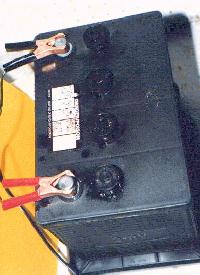
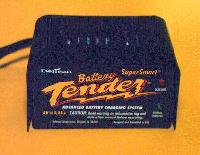 |
Up your
voltage? - EWE BOAT has been a wonderful
traveling companion but in years past after sustained running she would refuse
to start until the engine cooled down. Bummer! This problem was solved by
replacing the 6 volt battery with an 8 volt battery. An 8
volt battery is readily available from Exide or NAPA and is
available in a variety of sizes. My engine starts on the first attempt every
time and my lights are brighter. If you go to 8 volts be sure to adjust the
charging rate on your generator for a max of 15 amps.
Now the $ 64 question, how do you charge an 8 volt battery?
With an 8 volt battery charger! This one is called
the "Super Smart" Battery Tender. It is manufactured by a company
called Deltran. I purchased it from Halon Marketing in Pennsylvania. Deltran
also makes a 6 and 12 volt model. |
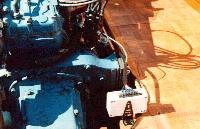
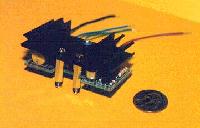 |
A
transistorized ignition for 6, 8 and 12 volt systems -
THIS THING IS GREAT! We found this kit in Belgium. It is
basically a transistorized set of points that unloads your points and saturates
your ignition coil. You get to keep your existing distributor, points and
plugs. The end results are no more point maintenance and you get a nice hot
spark at the plug. I did a rough measurement and found that the voltage at the
plug went from about 12,000 to 30,000 volts. You can build it yourself or Last
Chance Marina will build one for you. Installation takes about 5 minutes. (The
coin in the picture is an American Quarter ....) |
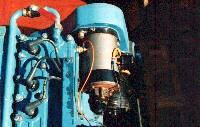 |
A shocking
topic - spark plug cables! - I was using a
digital VOM to check the charging voltage of the generator when I discovered
that the EMF radiation was so great from my solid core spark plug cables that
it rendered the VOM useless when the engine was running. I went to the local
auto supply and bought a set of Accel Spiral Wound spark plug cables. Low loss,
low noise and now my VOM works. |
|

|
Fuses -
gotta have 'em. Know where to put 'em? - |
|

|
On the
water you still need ground - |
|
|
A scary
story with a happy ending - This article was
printed in the Fall 1997 issue of the Fourth Watch, the quarterly publication
of the Adirondack Chapter of the Antique and Classic Boat Society. This article
has been reprinted here with permission from the author, Scott Dorrer. Read it
and heed! "THE ELECTRICAL SYSTEM"
|
| Stuff & Sources |
| 8 Volt DC Battery |
Exide or NAPA |







